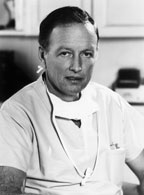
On May 3, 1968, Dr. Denton Cooley, a Houston native, successfully performed the first heart transplant in the United States. The patient was Everett Thomas, an accountant whose heart had been damaged by rheumatic fever. Dr. Cooley performed the transplant at St. Luke’s Hospital in the Texas Medical Center in Houston. Mr. Thomas survived 204 days.
In April 1969, Dr. Cooley placed the first artificial heart into Haskell Karp, of Skokie, Illinois. Mr. Karp was suffering from heart failure and was in danger of immediate death without a new heart. The artificial heart kept Mr. Karp alive for 64 hours until a donor heart became available. Unfortunately, Mr. Karp survived only 32 hours after the artificial heart was replaced by a human heart.
At this time Cooley worked closely with Dr. Michael DeBakey, a senior cardiologist. Cooley performed this surgery without DeBakey’s supervision, causing a rift between the two doctors. One result of the rift was that Cooley resigned from his position at Baylor College of Medicine. The rift lasted for 38 years until 2007. DeBakey accepted an honorary membership in the Denton A. Cooley Cardiovascular Surgery Society with a handshake from Cooley. Denton Arthur Cooley was born in 1920. His father was a successful dentist and his maternal grandfather was a physician who played a role in the development of the Heights area of Houston. Cooley had a complicated relationship with his father, who was an alcoholic and died prematurely from complications of that alcoholism.
After graduation from high school at age 17, Cooley enrolled as a predental student at the University of Texas where he played basketball. Challenged with a dare, he visited a nearby hospital emergency room where an intern let him suture a patient’s lacerations. Cooley decided to switch to premed and transferred to the University of Texas Medical Branch in Galveston. Because of unrest at the school, he transferred to Johns Hopkins School of Medicine in Baltimore, Maryland.
At Johns Hopkins Cooley met Dr. Alfred Blalock, a pioneer in cardiology. Blalock became his mentor and a father figure he missed growing up. After receiving his M.D. degree in 1944, he assisted Dr. Blalock in repairing an infant’s congenital heart defect. The operation was called the “Blue Baby” procedure.
During World War II Cooley joined the Army Medical Corps and was assigned as chief of surgical services at the station hospital in Austria. Discharged as a captain after the war, Cooley returned to Johns Hopkins to finish his residency and became a surgery instructor. In the 1950s he moved to Houston to become an associate professor of surgery at Baylor College of Medicine where he worked for 18 years. He also worked through Methodist Hospital. He founded the Texas Heart Institute in 1962. During his career, Cooley was Chief of Cardiovascular Surgery at Baylor St. Luke’s and Clinical Professor of Surgery at the University of Texas Health Science Center. He either authored or co-authored 1,400 scientific articles and 12 books. Cooley performed his last surgery at age 87.
President Ronald Reagan presented Cooley with the Presidential Medal of Freedom in 1984 for his contributions to the field of medical science. President Bill Clinton presented Cooley with the National Medal of Technology in 1998 for his technological innovation.
Cooley married Louise Goldborough Thomas, a registered nurse, in 1949. They had five daughters. Cooley played golf and was an upright bass player in a swing band called The Heartbeats. He also remained a loyal University of Texas supporter. Cooley once sent a telegram of support to a Longhorn football pep rally that said, “Win or lose, I’m behind you with all my hearts.”
Cooley died at the age of 96 on November 18, 2016.

